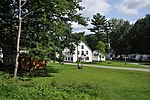Hartford (village), Vermont
Census-designated places in VermontCensus-designated places in Windsor County, VermontHartford, VermontHistoric districts in Windsor County, VermontHistoric districts on the National Register of Historic Places in Vermont ... and 5 more
NRHP infobox with nocatNational Register of Historic Places in Windsor County, VermontUnincorporated communities in VermontUnincorporated communities in Windsor County, VermontUse mdy dates from July 2023

Hartford is one of five unincorporated villages in the town of Hartford, Windsor County, Vermont, United States. It is also referred to as Hartford Village. For the 2020 census it was listed as a census-designated place, with a population of 754, out of 10,686 in the entire town of Hartford. Hartford is the birthplace of Horace Wells, the first dentist to use nitrous oxide or "laughing gas" as anesthesia.
Excerpt from the Wikipedia article Hartford (village), Vermont (License: CC BY-SA 3.0, Authors, Images).Hartford (village), Vermont
Hillridge Road,
Geographical coordinates (GPS) Address Nearby Places Show on map
Geographical coordinates (GPS)
| Latitude | Longitude |
|---|---|
| N 43.6625 ° | E -72.339722222222 ° |
Address
Hillridge Road 106
05001
Vermont, United States
Open on Google Maps







